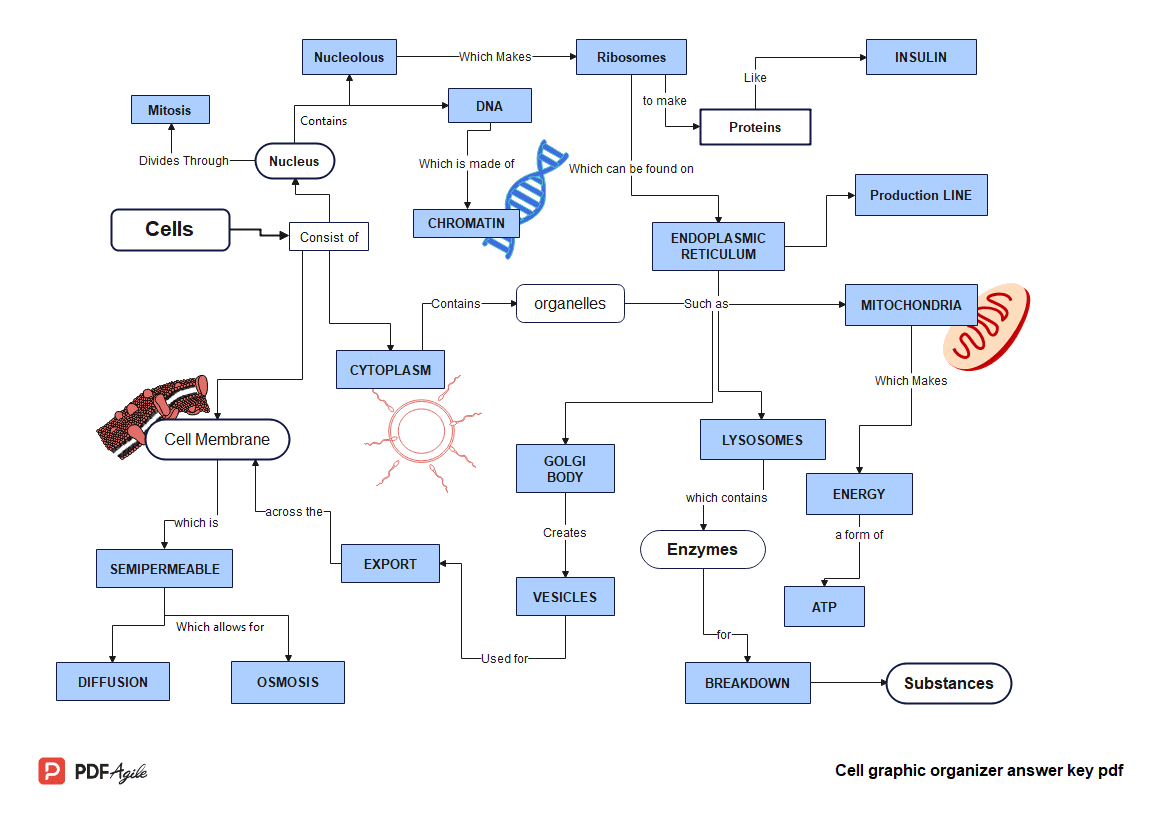What is a Cell Graphic Organizer?
A cell graphic organizer answer key pdf is a concept map that illustrates the relationship between cell structures, complex biomolecules, cell membranes, organelles, and other minuscule components. Graphic organizers are the best learning tool for students as they visualize science and biology concepts and structures instead of using plain text to improve students' comprehension. They also help students see the bigger picture of the concept and focus on every component to understand their relationship. Cell graphic organizers make it easier to explain anatomy and biology concepts.
Graphic organizers help students understand science concepts with a descriptive model of organisms, their structures and functions, and phenomenon. A cell is a basic functional unit of living organisms, and understanding its internal structure and relationships is important for biology and science students. Teachers use graphic organizers such as concept maps to help students comprehend basic and complex systems, record observations, and link that information with previously known facts.
Benefits of Cell Graphic Organizer
Cell graphic organizers are best for the visual representation of cell structures. They allow students to easily record a large amount of information and develop metacognitive skills such as brainstorming and critical thinking. It enables them to quickly understand everything related to cell structures and retain that information as they can organize and compare their thoughts and concepts. Teachers use the cell graphic organizer answer key pdf to create a guide for their students. Here are the benefits of using cell graphic organizers.
- Taking notes and reading plain text doesn't capture all the details of biology and science concepts because the visual representation of those concepts and experiments is beneficial for student comprehension. Cell graphic organizers allow students to focus on the key details and understand their connection with more interest.
- Cell graphic organizers benefit all students of the class because it is proven that learning from graphical representations is better than any other learning method. Once they see the visualization of cell structures, they quickly understand the hierarchy of structures and examine connections.
- Educators use cell graphic organizers to enhance student learning and engagement in class. Graphic organizers are best for classroom exercises and student homework because they spark student interest, letting them participate in class more to ask questions, communicate with others, improve brainstorming and idea generation, and develop critical thinking.
How to Use Cell Graphic Organizer
With the help of a cell graphic organizer answer key, students can organize their concepts and structure their thoughts to showcase their comprehension. There are many components in a cell structure, and using text to explain those components only tells students their names but not their position and sequence in the cell. An answer key illustrates the internal structure of a cell with clear links so students can understand its functions and the hierarchy of components. Here are the steps to use a cell graphic organizer.
STEP 1: Download the cell graphic organizer pdf template and customize it based on the number of components you will illustrate in the concept map. To create an easy-to-understand graphical representation, make sure that connectors don't cross each other. Add enough space to show their relationship with connectors clearly.
STEP 2: Based on the text you are reading, identify the major concepts and components of the cell before adding them to the graphic organizer. In a cell structure, the main components are organelles, enzymes, cell membranes, proteins, and nuclei. Start with adding cells on one side and add other components gradually.
STEP 3: Organize the remaining components into categories and put them in different groups, such as the cell membrane containing osmosis, diffusion, export, the nucleus linked with mitosis, DNA, nucleons, etc. Leave enough space to make changes if you get something wrong.
STEP 4: Concept maps showcase the relationship of structural components of the entities it visualizes. Arrowheads depict how the ideas and components are connected. In the case of cell structures, the last step is to add connectors to depict the link between cell components. Use icons to represent specific categories.
Free Cell Graphic Organizer Answer Key PDF Download
Download and edit cell graphic organizer answer key PDF templates for free to learn everything about cell structures and functions. Use PDF Agile to edit your cell graphic organizer pdf with pro editing tools and many unique features that allow users to merge, convert, cut, and compress PDF documents in a few clicks. It also allows you to copy and extract text, and share pdf files with others. PDF Agile supports multiple formats, which enable the user to convert files from PDF to Word, Excel, PPT, TXT, image, and CAD formats.




